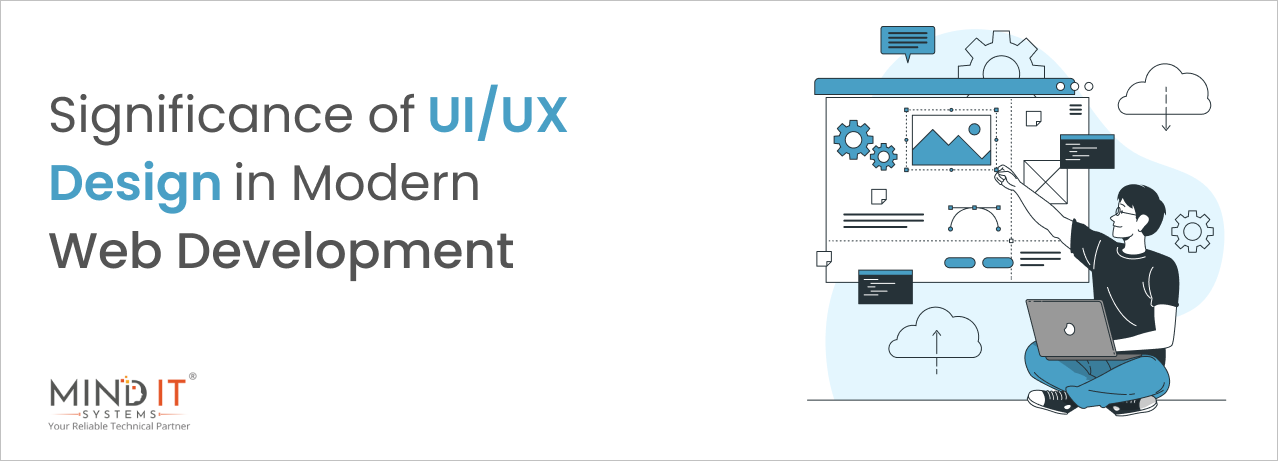
Significance of UI/UX Design in Modern Web Development
Introduction
The significance of UI/UX design in the constantly changing field of modern web development cannot be underestimated. However, many entrepreneurs, driven by a “launch early” mentality, often overlook the critical value of investing in quality UI and UX design. This oversight frequently leads to products failing to meet user expectations, resulting in design debt issues and requiring costly revisions in the future.
As technology advances and user expectations soar, businesses must recognize the pivotal role that intuitive and visually appealing design plays in attracting and retaining users. A well-designed interface captivates and ensures a seamless and satisfying user experience.
In this article, we delve into the essence of UI/UX design, its impact on web development in modern day, and its profound implications for user experience, branding, and marketing strategies.
So, let’s get started.
What is UI/UX Design?
UI/UX design, an amalgamation of User Interface (UI) and User Experience (UX) design, involves creating interfaces that are not only visually appealing but also intuitive, seamless, and user-friendly.
User Interface (UI): This component concentrates on the look and feel of a website or application. It includes buttons, icons, spacing, typography, color schemes, and overall visual layout. Essentially, UI is about ensuring that the visual aspects of a site or app are engaging and easy to interact with.
User Experience (UX): This involves delving into the overall experience and usability of the site or app. UX design analyzes the user journey, from the initial interaction to the concluding conversion, and optimizes every touchpoint to ensure satisfaction and engagement. It’s about creating a product that gives users a meaningful and relevant experience, putting their needs and preferences at the forefront.
Transform your digital experience into a user-centric masterpiece
Explore the possibilities today!
The Importance of UI/UX Design in Modern Web Development
In today’s highly competitive digital landscape, where users are bombarded with countless options, UI/UX design plays a crucial role.
Here’s why UI/UX design is so vital in modern web development:
- Captivates Users’ Attention: A well-crafted design not only grabs users’ attention but also retains it. First impressions are often formed within seconds of landing on a website, and an attractive UI can make a significant difference.
- Foster’s Trust and Credibility: Intuitive and professional designs build trust and credibility with users. A web page that looks modern and functions smoothly is likely perceived as reliable.
- Enhances Accessibility: Good design ensures all users, including those with disabilities, can navigate the site easily. This inclusivity broadens your audience and shows that your brand values all its customers.
- Smooth Navigation: Simplified navigation paths enhance the overall user experience. When users can easily and quickly find what they need, they are more likely to stay longer and engage more deeply with the content.
How UI/UX Design Affects User Experience?
UI/UX design directly shapes how users interact with a website or application, shaping their perception and satisfaction.
Consider the following impacts:
First Impressions Matter. A visually appealing UI creates a positive first impression. Users who find the design attractive are more likely to stay and explore.
User Retention: Seamless navigation and fast load times encourage users to stay longer. Frustrations caused by poor design or slow performance can drive users away.
User Engagement: It’s not just about the content, but also about how it’s presented. Engaging visuals and intuitive layouts can be powerful tools to prompt users to explore more. Well-placed call-to-actions and appealing graphics can keep users engaged, showcasing the potential of a well-designed UI and UX.
Conversion Rates: An optimized UX design can increase conversion rates by guiding users smoothly through the journey. A clear and logical flow from the landing page to the checkout or contact form can significantly improve conversion metrics.
The Role of UI/UX Design in Branding and Marketing
Beyond enhancing user experience, UI/UX design shapes brand identity and fosters brand loyalty.
Here’s how:
- Consistent Design Language: A cohesive visual style reinforces brand recognition. Uniformity in design aspects, such as colors, fonts, and imagery, assists in creating a solid brand identity.
- Positive Brand Image: A seamless user experience reflects positively on the brand. Users associate the quality of their interaction with the brand’s quality.
- Brand Loyalty: Happy users can become loyal customers and upholders for the brand. A positive experience encourages repeat visits and can lead to word-of-mouth referrals.
Critical Elements of Effective UI/UX Design
Creating a successful UI/UX design requires more than a keen eye for aesthetics. It demands a comprehensive, user-centered approach integrating research, strategic planning, and iterative testing. Designers must consider a range of essential elements to develop visually appealing, highly functional, and user-friendly interfaces.
Listed below are the key components that contribute to an effective UI and UX design:
1. User Research
Understanding the target audience, their preferences, behaviors, and pain points is paramount to designing a user-centric experience. This involves gathering data through surveys, interviews, and analytics. Knowing your audience helps craft a design that resonates with their needs and expectations.
2. Wireframing and Prototyping
Creating wireframes and prototypes allows designers to envision the layout and functionality of the interface, facilitating iterative improvements based on user feedback. These tools help test and refine ideas before full-scale development, ensuring the final product meets user expectations.
3. Visual Design
Attention to typography, color schemes, imagery, and branding elements ensures a visually compelling and cohesive design. A solid visual design creates an emotional connection with users and enhances engagement. The visual elements must align with the brand’s identity and appeal to the target audience.
4. Usability Testing
Conducting usability testing helps identify any usability issues or pain points early in the design process, enabling refinements for an optimal user experience. This step involves real users interacting with the design to uncover improvement areas. Continuous testing is necessary for maintaining a user-friendly design.
Conclusion
In the digital age, where user experience rules supreme, UI/UX design emerges as a cornerstone of modern web development. Businesses can enhance user satisfaction and drive conversion, retention, and brand loyalty by prioritizing intuitive design, seamless navigation, and engaging visuals.
Partnering with a reputable UI/UX design services agency and embracing a user-centric design approach is imperative for businesses seeking to grow in today’s competitive landscape. Investing in UI/UX design is not just about aesthetics; it’s about creating meaningful, efficient, and enjoyable interactions that meet user needs and drive business success.
Organizations can set themselves apart in the crowded digital marketplace by understanding and implementing effective UI and UX design processes, ensuring their websites and applications meet and exceed user expectations. As the digital terrain continues to evolve, the importance of User Interface (UI) and User Experience (UX) design in web development is bound to grow, making it a crucial element for businesses aiming to succeed online.
Share this post
About the Author

Sujoy Roy
(Head – Digital Marketing)
From my teenage time, I had a quench to solve problems and loved leadership. Starting my career in relation management, ignited my passion for managing people. While managing I realized technology needs to be incorporated to keep pace with the changing world & do my work efficiently.

